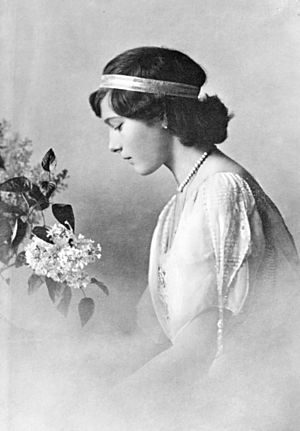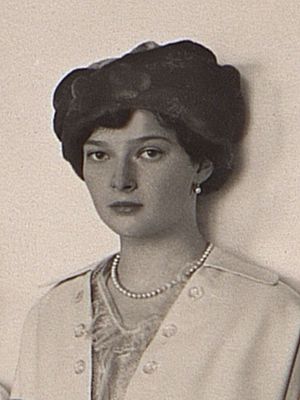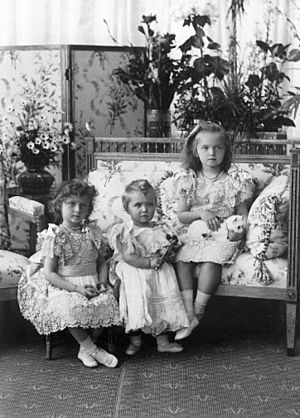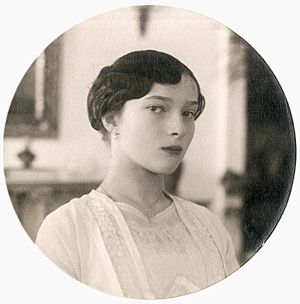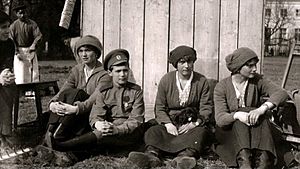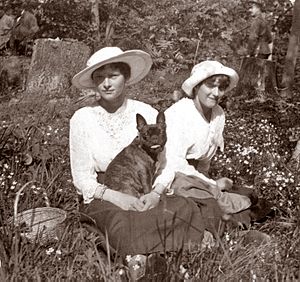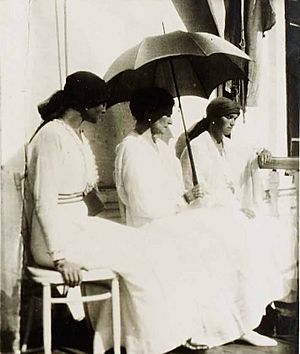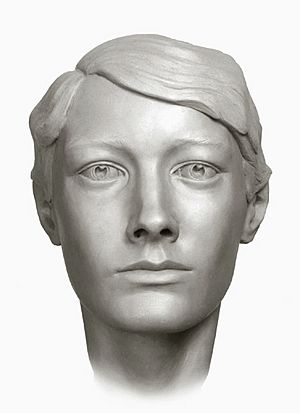Grand Duchess Tatiana Nikolaevna of Russia facts for kids
Quick facts for kids Grand Duchess Tatiana Nikolaevna |
|||||
|---|---|---|---|---|---|
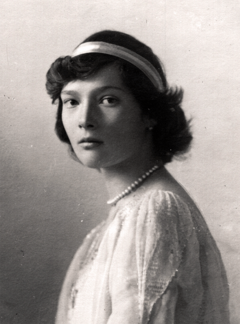
Grand Duchess Tatiana, 1914
|
|||||
| Born | 10 June 1897 Peterhof Palace, Saint Petersburg, Russian Empire |
||||
| Died | 17 July 1918 (aged 21) Ipatiev House, Yekaterinburg, Russian Soviet Republic |
||||
| Burial | 17 July 1998 Peter and Paul Cathedral, Saint Petersburg, Russian Federation |
||||
|
|||||
| House | Holstein-Gottorp-Romanov | ||||
| Father | Nicholas II of Russia | ||||
| Mother | Alix of Hesse | ||||
| Religion | Russian Orthodox | ||||
| Signature |  |
||||
Grand Duchess Tatiana Nikolaevna of Russia (born Tatiana Nikolaevna Romanova; June 10, 1897 – July 17, 1918) was the second daughter of Tsar Nicholas II. He was the last emperor of Russia. Her mother was Tsarina Alexandra. Tatiana was born at Peterhof Palace, near Saint Petersburg.
Tatiana was the younger sister of Grand Duchess Olga. She was the older sister of Grand Duchess Maria, Grand Duchess Anastasia, and Tsarevich Alexei. People often called her "the governess" among her siblings. This was because she was a bit bossy but also very caring. Tatiana was very close to her mother, Tsarina Alexandra. She often spent hours reading to her.
During World War I, Tatiana helped lead many charity groups. She also trained to be a nurse with her older sister, Olga. From 1914 to 1917, she helped wounded soldiers at Tsarskoye Selo. Her time as a nurse ended when her family was arrested in 1917. This happened after the first Russian Revolution.
Tatiana and her family were killed by Communist revolutionaries on July 17, 1918. Later, the Russian Orthodox Church made her a saint. For a while, there were rumors that some of the Romanovs had survived. Many people pretended to be them. However, scientific proof has shown that all of the Tsar's family died at the hands of the Bolsheviks.
Contents
Tatiana's Look and Personality
Tatiana was known for her beauty. She was tall, slim, and graceful. She had dark red-brown hair, gray eyes, and delicate features. Many people thought she was the most beautiful of the four Grand Duchesses. They also said she looked the most like her mother. Her mother's lady-in-waiting, Baroness Sophie Buxhoeveden, said Tatiana was "prettier than her sisters." She added that Tatiana was "strikingly good looking."
Even though she was a Grand Duchess, Tatiana did not use her royal title. Her friends, family, and servants called her by her first name and middle name, Tatiana Nikolaevna. She was known to be very practical and a natural leader. Her sisters called her "The Governess." They would often send her to ask their parents for favors.
Tatiana was more serious and quiet than her older sister, Olga. She wasn't as naturally smart as Olga, but she worked harder and was more dedicated. She was also very interested in fashion. She knew how to wear clothes well and enjoyed being admired. Her mother's friend, Anna Vyrubova, said Tatiana was good at embroidery and could even style her mother's hair like a professional.
Tatiana was the most outgoing of her sisters. She wanted to have friends her own age. However, her high rank and her mother's dislike of social events limited her social life. Like her mother, Tatiana was very religious. She read her Bible often and thought deeply about right and wrong.
Tatiana was shy and reserved at first. But once you got to know her, she was very warm and caring. She was a thoughtful person who dreamed of strong friendships. She was also very close to her mother. Many people believed she was Alexandra's favorite daughter. Her father, the Emperor, also loved her very much.
Early Life
Tatiana was born on June 10, 1897. She was the second child of Emperor Nicholas II and Empress Alexandra. When she was born, her mother was sad that she was another daughter. This was because the rules meant only a son could inherit the throne. Tatiana's siblings were Grand Duchesses Olga, Maria, Anastasia, and Tsarevich Alexei. All the children were very close to each other and their parents.
Tatiana's title was "Grand Princess," but it was usually translated to "Grand Duchess" in English. This title meant she was higher in rank than other European princesses.
Like the other Romanov children, Tatiana was raised simply. She and her sisters slept on simple beds without pillows. They took cold baths in the morning. They also did embroidery and knitting. These items were given as gifts or sold for charity.
Tatiana and Olga were known as "The Big Pair." They shared a bedroom and were very close. When Olga got sick with typhoid fever in 1901, Tatiana was very upset. She cried when she saw how thin and pale Olga was. She found it hard to believe it was her beloved sister.
Relationship with Grigori Rasputin
Tatiana loved her younger brother, Tsarevich Alexei, very much. Alexei had a serious illness called hemophilia. This meant his blood did not clot properly. Tatiana, her mother, and her three sisters could all carry the gene for hemophilia. Their grandmother, Queen Victoria, had passed it down.
The Tsarina relied on Grigori Rasputin, a Russian peasant and holy man. She believed his prayers helped Alexei when he was sick. Tatiana and her siblings called Rasputin "Our Friend." They often shared their thoughts with him. In 1909, Rasputin sent them a telegram. He told them to "Love the whole of God's nature." Tatiana, at age 11, once wrote to Rasputin. She asked him to visit and said she was sad to see her mother ill.
Even with some rumors about him, the Imperial family stayed close to Rasputin. This continued until he was killed in 1916. Tatiana, her mother, and her sisters signed an icon that was buried with Rasputin. Tatiana even kept a notebook where she wrote down things Rasputin said about love.
Young Adulthood and World War I
As a teenager, Tatiana was made an honorary colonel. She was given a group of soldiers called the Vosnesensky Lancers. She and Olga would regularly inspect the soldiers. In 1911, Tatiana and Olga saw the assassination of a government minister, Pyotr Stolypin, at an opera house.
When World War I began, Tatiana became a Red Cross nurse. She worked with her mother and Olga. They cared for wounded soldiers in a hospital at Tsarskoye Selo. Tatiana was very skilled and dedicated. She was only sad that her youth meant she couldn't help with the most difficult cases. She was also very patriotic. In 1914, she became the patron of a war aid group called the Tatiana Committee.
Tatiana wished she could do more for Russia during the war. She wrote to her mother, saying she was sorry she wasn't a man so she could help more. As she grew up, Tatiana took on more public duties than her sisters. She also led various committees.
Captivity
The family was arrested during the Russian Revolution of 1917. They were first held at Tsarskoye Selo. Later, they were moved to private homes in Tobolsk and Yekaterinburg, Siberia. This sudden change and the uncertainty of being prisoners affected Tatiana and her family deeply. Tatiana missed her nursing work. She wrote to a fellow nurse, saying it was strange to be healthy but not be able to help.
In April 1918, the Bolsheviks moved Nicholas, Alexandra, and Maria to Yekaterinburg. The other children stayed in Tobolsk because Alexei was too sick to move. Tatiana was the one who convinced her mother to go with her father. Alexandra decided that Tatiana should stay behind to manage the household and care for Alexei.
During the month they were separated from their parents and sister, Tatiana, Olga, and Anastasia sewed jewels into their clothes. They hoped to hide them from their captors. This plan worked, and the Bolsheviks did not find the jewels until after the family's death.
Death
In Yekaterinburg, Tatiana sometimes talked with some of the guards. She asked them about their families and spoke about her hopes for a new life in England. She was polite to the guards if they behaved well. Later, new rules stopped the family from talking with the guards. Tatiana, still the family leader, often asked the guards about the rules or what would happen next. She also spent a lot of time with her mother and sick brother, reading to them or playing games.
At the Ipatiev House, Tatiana and her sisters had to do their own laundry and bake bread. She used her nursing skills in June 1918. She gave an injection to Dr. Eugene Botkin to help his kidney pain.
On July 14, 1918, priests held a church service for the family. They noticed that Tatiana and her family knelt during the prayer for the dead, which was unusual. Tatiana's last notebook entry was a quote from a holy man: "Your grief is indescribable... join your grief to his, in it you will find consolation."
On July 15, Tatiana and her sisters seemed happy. They joked and helped cleaning women scrub the floor. They wore long black skirts and white silk blouses. They told the women they enjoyed physical work. On the afternoon of July 16, Tatiana read from the Bible with her mother. Later, they just talked. That night, the family was told to go downstairs for their safety.
They carried pillows and bags to make Alexandra and Alexei comfortable. They asked questions but did not seem to know they would be killed. The head guard, Yakov Yurovsky, told them to stand. He then read a paper saying they would be executed. Tatiana and her family had only a moment to react before the guards began shooting. This happened in the early hours of July 17, 1918.
Romanov Graves and DNA Proof
For many years, some people believed that one or more family members survived the killings. These ideas lessened when most of the family's bodies were found in a mass grave in 1991. This grave was in a forest outside Yekaterinburg. The remaining theories focused on two missing bodies: Tsarevich Alexei and one of the four Grand Duchesses. People often thought it was Grand Duchess Maria or Anastasia. Some authors even claimed Tatiana might have been rescued and lived in England.
However, on August 23, 2007, archaeologists found two more skeletons near Yekaterinburg. Tests showed a high chance that these remains belonged to Tsarevich Alexei and one of his sisters. On April 30, 2008, DNA tests proved this. With these results, all of the Tsar's family members have been found and identified.
Sainthood
| Saint Tatiana Romanova | |
|---|---|
| Saint, Grand Duchess and Passion bearer | |
| Honored in | Russian Orthodox Church |
| Canonized | 1981 and 2000 by Russian Orthodox Church Abroad and the Russian Orthodox Church |
| Major shrine | Church on Blood, Yekaterinburg, Russia |
| Feast | 17 July |
In 1981, Tatiana and her family were made saints by the Russian Orthodox Church Outside Russia. They were recognized as holy martyrs. In 2000, the Russian Orthodox Church also made Tatiana and her family saints, calling them passion bearers.
The bodies of Tsar Nicholas II, Tsarina Alexandra, and three of their daughters were buried at St. Peter and Paul Cathedral in St. Petersburg. This happened on July 17, 1998, exactly eighty years after they were killed.
Images for kids
See also
 In Spanish: Tatiana Nikoláyevna de Rusia para niños
In Spanish: Tatiana Nikoláyevna de Rusia para niños


